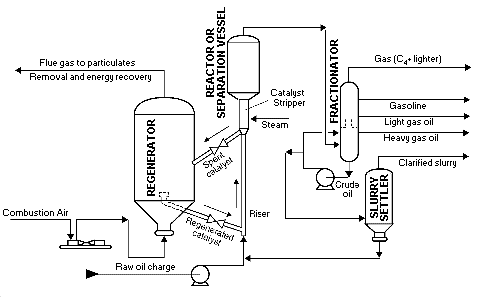Catalytic cracking breaks complex hydrocarbons into simpler molecules in order to increase the quality and quantity of lighter, more desirable products and decrease the amount of residuals. This process rearranges the molecular structure of hydrocarbon compounds to convert heavy hydrocarbon feedstock into lighter fractions such as kerosene, gasoline, LPG, heating oil, and petrochemical feedstock.
Catalytic cracking is similar to thermal cracking except that catalysts facilitate the conversion of the heavier molecules into lighter products. Use of a catalyst (a material that assists a chemical reaction but does not take part in it) in the cracking reaction increases the yield of improved-quality products under much less severe operating conditions than in thermal cracking. Typical temperatures are from 850°-950° F at much lower pressures of 10-20 psi. The catalysts used in refinery cracking units are typically solid materials (zeolite, aluminum hydrosilicate, treated bentonite clay, fuller’s earth, bauxite, and silica-alumina) that come in the form of powders, beads, pellets or shaped materials called extrudites.
There are three basic functions in the catalytic racking process:
- Reaction – Feedstock reacts with catalyst and cracks into different hydrocarbons;
- Regeneration – Catalyst is reactivated by burning off coke; and
- Fractionation – Cracked hydrocarbon stream is separated into various products.
The three types of catalytic cracking processes are fluid catalytic cracking (FCC), moving-bed catalytic cracking, and Thermofor catalytic cracking (TCC). The catalytic cracking process is very flexible, and operating parameters can be adjusted to meet changing product demand. In addition to cracking, catalytic activities include dehydrogenation, hydrogenation, and isomerization.
-
Catalytic Cracking Processes
|
Feedstock |
From |
Process |
Typical products – to – unit |
|
Deasphalted oils |
Deashpalter |
Decomposition, alteration |
|
|
Gas oils |
Towers, coker visbreaker |
Decomposition, alteration |
|
